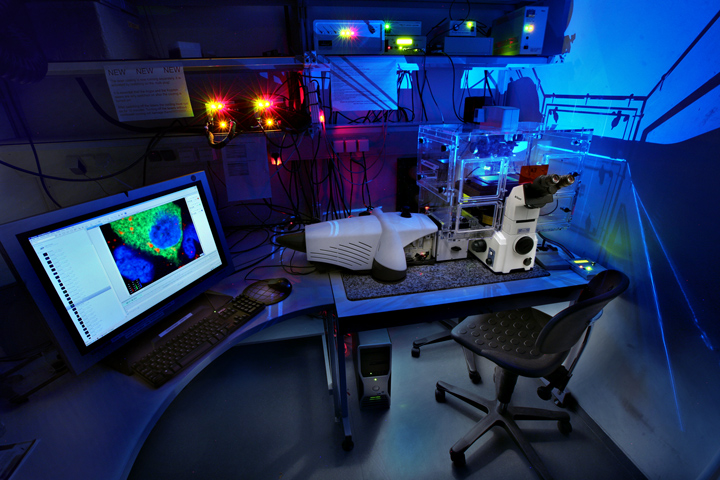ERS-6 spinning disk confocal microscope
Profile: Confocal microscope of the spinning disk type. Much higher sensitivity and faster image acquisition compared to point scanning confocals but confocality is limited to high magnification. Of the original 6 laser (405, 440, 488, 515, 561 and 640nm) only 405, 440, 561 and 640 are available as the Argon Ion Laser is not working any more. Due to the age of the system, it will not be repaired. It may be used at the moment with the 4 remaining laser lines at reduced fees.
The PerkinElmer ERS-6 is a confocal microscope of the "spinning disk" (aka "nipkow disk") type. Here about 1,000 laser beamlets continuously sweep over the field of view, excite the fluorochromes in the sample, whose emission is recorded by a ultra sensitive EMCCD camera. Because each beamlet is quite dim, phototoxicity is relatively low and at the same time the quantum efficiency of a EMCCD camera is considerably higher than that of a photomultiplier used by a "normal" point scanning confocal microscope meaning that more photons can be detected.This allows for higher framerates (up to 30 images per second) as opposed to the typical one image per second achieved by point scanning devices.
EB3 microtuble plus-ending marker dynamics
A limitation comes from the fact that the pinholes required to gain confocality cannot be adjusted in size so that confocality is only obtained with a 100x oil immersion objective, limiting the field of view to about 80 x 80 µm. Also the penetration depth is lower as compared to a point scanning confocal (around 20 µm versus typically 100 µm). This means that the ERS-6 is especially well suited for imaging of single cells, fixed or live, even for a longer period of time. Lower magnifying objectives are also available (60x oil immersion, 60x water immersion, 20x dry). With these confocality is a little bit reduced but blur resulting from extrafocal signal is still low and not comparable to a widefield (= non confocal) microscope.

Components
Nikon TE-2000 inverted microscope with
- Nikon Plan Apo λ 100x NA 1.45 oil immersion objective (working distance 0.13mm)
- Nikon Plan Apo VC 60x NA 1.2 water immersion objective (working distance 0.27mm)
- Nikon Plan Apo 20x NA 0.75 dry objective (working distance 1.0mm)
An environmental box is encasing the microscope allowing for temperature-, CO2- and humidity control.
Yokagawa CSU-22 confocal scanning unit
Hamamatsu C9100-02 EMCCD camera, 1000 x 1000 pixel, 8 µm pixel size
PerkinElmer Photokinesis bleaching/photoactivation unit
Lasers of 405, 440, 488, 515, 561 and 640nm wavelength for fluorochrome excitation.
Detection
The filter sets in the ERS-VoX allow to detect fluorochrome emission in the following ranges (center wavelength [nm]/bandwidth [nm]):
- "Green": 527/55
- "Blue/Red": dual pass filter 445/60 and 615/70
- "Cyan/Far Red": dual pass filter 485/60 and 705/90
- "Yellow": 587/125
Image acquisition with PerkinElmer Volocity software. Analysis versions of Volocity may be used free of charge in our computer room, U04.



